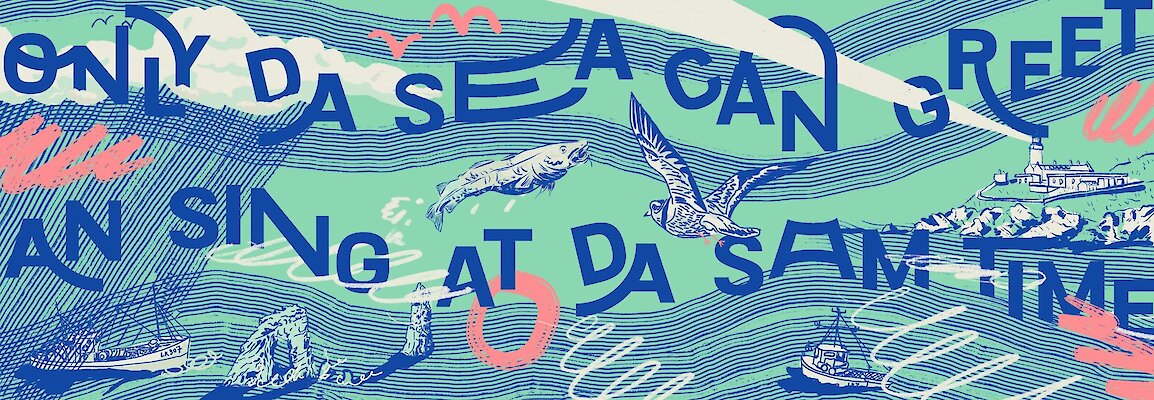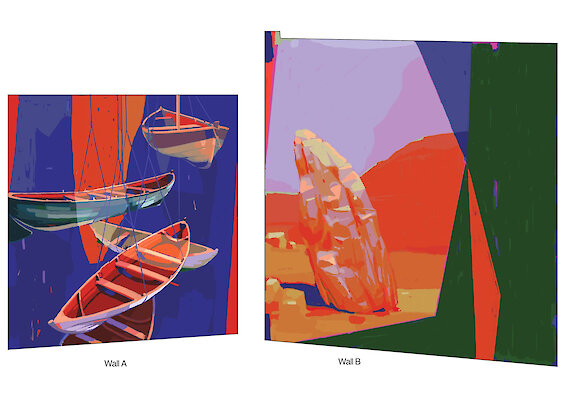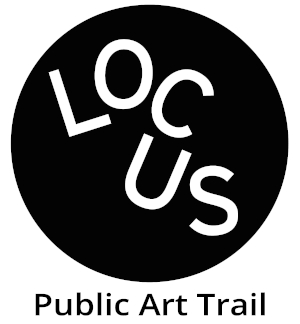The second phase of the LOCUS project saw two new murals commissioned for the town centre of Lerwick, adding to the LOCUS public art trail of four public sculptures.
Four mural designs were created and a public vote determined the winning two. These were completed in the Summer 2021.
Cobolt Collective are a mural collective based in Glasgow seeking to transform walls into ones that exudes positivity, encouragement and/or celebration for the people it is designed to be used by. Founded by Erin Bradley-Scott, Chelsea Frew, Kat Loudon and Edda Karólína Ævarsdóttir, the collective has continued to work throughout lockdown, most recently creating Power tae the key workers, a Glasgow-wide poster campaign to highlight and celebrate key workers during the COVID-19 pandemic. Watch the action here
Only Da Sea is locted on the Shetland Property Lets/Dowry wall on the Esplanade street-level, adjacent to the Peerie Shop & Café. Their work takes the sea as its subject, connecting local references and narratives, making a strong visual link between the busy street and Bressay Sound beyond.
Gavin Renshaw considers topography, local heritage and the ability to respond to built environments, with a strong focus on its architectural infrastructure. He often associates with outsider art and graffiti culture, and explores the topophilia associated with place. This can take the form of photograhy, painting, map-making or print.
Gavin's work sits on two walls on Commercial Street, on the side wall of Bayes and the side wall of No.88, down Peterson’s Closs. The intention is to create a dialogue between the two. Gavin explains, “I wanted to keep my design quite playful in response to the brief yet still have a deeper undercurrent of meaning hidden within the two walls. The concept behind the work was to look at the intrinsic relationship and historical connection that Shetland has between land and sea in regard to not only livelihood and travel but in the spiritual and primal sense of ancient and future culture."
Watch the mural taking shaped here

We began the design process by speaking to as many islanders as possible in order to gain a better understanding of what life on the island is like and how this could link to the theme of “Where we were, where we are, and where we’re going". It is these conversations that have influenced our design for the mural.
A consistent visual that recurred in our conversations was the sea and its deep-rooted ties to Shetlandic culture. The island has changed dramatically over the years, yet the sea has remained a constant. At the same time, the sea has been, and continues to be, an integral part of the island’s identity and growth.
The sea is a place of work and pleasure for Shetlanders, and has been for centuries. It has welcomed new people and said goodbye to others. It is home to a wealth of living things from orcas to otters, and is almost like a living creature of its own. The rhythm of the waves is like the heartbeat of the island, steady and constant, and this has been, and still is, a comforting presence for people during difficult times.
Continuing with the theme of rhythm, another important element we wanted to depict in the artwork was Shetland dialect, music and poetry. It was apparent from our discussions that it is intrinsic to the local culture and heritage, and so we were keen to include this in the design.
We chose a line from Discontinuity, by Shetland born poet Christine De Luca - “Only da sea can greet an sing at da sam time". Shetland has strong traditions in appreciating poetry, and we felt this line captures the idea of the sea being a living thing, capable of its own emotions, singing to its own melody and rhythm. We have extended and warped some of the letters to try and mimic how the poem sounds when it is spoken out loud, again tying in with the theme of rhythm and sound.
Overall, we believe that this design captures the independent spirit of the community, celebrates Shetland’s rich heritage and traditions, looks towards a bright future for the community, and injects more colour and positivity onto The Street.
(Cobolt Collective)
Gavin Renshaw considers topography, local heritage and the ability to respond to built environments, with a strong focus on its architectural infrastructure. He often associates with outsider art and graffiti culture, and explores the topophilia associated with place. This can take the form of photograhy, painting, map-making or print.
www.gavinrenshaw.com |@mrteaone
Gavin's work will be painted on two adjacent walls on Commercial Street, on the side wall of Bayes and the side wall of No.88, down Peterson’s Closs. The intention is to create a dialogue between the two. Gavin explains, “I wanted to keep my design quite playful in response to the brief yet still have a deeper undercurrent of meaning hidden within the two walls. The concept behind the work was to look at the intrinsic relationship and historical connection that Shetland has between land and sea in regard to not only livelihood and travel but in the spiritual and primal sense of ancient and future culture."
“Objects which are in essence simple things but which hold great value in explaining that dependence upon land/sea and that interconnectivity between the two. I was instantly drawn to the Yoal, a cultural icon of the island. The standing stone looks out to sea, a beacon, an ancestor, a way marker? The Yoal looks for the stone, a reference to land. They are floating amongst two worlds, a way of navigating between them both, anchored to one, released to the other.
“In this way, maritime themes juxtapose ancient land structures, the proximity of which, allows a mimicry to occur and shapes are echoed between the two walls in a dialogue of colour.
(Gavin Renshaw)



